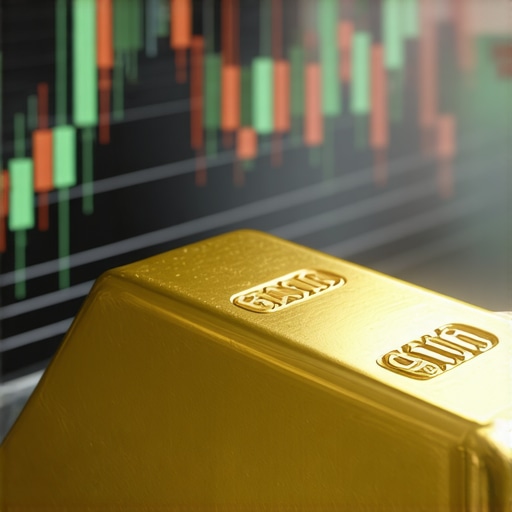Why Understanding Gold Supply Trends is Crucial for Investors
In the realm of investing, knowledge is power, and understanding gold supply trends is vital for making informed decisions. Gold has long been regarded as a safe haven asset, particularly during times of economic uncertainty. As an investor, grasping the dynamics of gold supply can significantly enhance your investment strategy and risk management.
One of the primary reasons why comprehending gold supply trends is essential is its direct impact on gold prices. Supply fluctuations can lead to price volatility, which can either benefit or harm your investment portfolio. For instance, an increase in global gold supply, perhaps due to higher mining outputs, could lead to a decrease in gold prices. Conversely, a reduction in supply—often influenced by geopolitical events or mining challenges—can drive prices up. Therefore, staying informed about these trends can help you time your investments more effectively.
Global Events and Their Influence on Gold Supply
The interplay between global events and gold supply cannot be understated. Political instability, natural disasters, and changes in regulations can all impact mining operations and, subsequently, the global supply of gold. For example, when countries with significant gold reserves experience turmoil, it often leads to a supply crunch, causing prices to soar. Understanding these events allows you to gauge potential market reactions and adjust your investment strategies accordingly.
Moreover, understanding the types of gold investments available can also be beneficial. Different forms of gold—such as physical gold, gold ETFs, and gold mining stocks—react differently to supply trends. For instance, gold ETFs are directly influenced by supply and demand metrics, while mining stocks may be affected by operational efficiencies and costs.
Anticipating Future Trends
Looking ahead, being aware of the key factors influencing gold supply can provide a strategic advantage. Factors such as technological advancements in mining, the discovery of new gold deposits, and shifts in global demand all play a crucial role in shaping future supply trends. For investors looking to maximize their returns, active monitoring of these trends is not just advantageous; it is essential.
In conclusion, understanding gold supply trends is more than just a matter of curiosity for investors; it is a critical component of a successful investment strategy. By keeping abreast of supply fluctuations and their implications on gold prices, you can make informed decisions that align with your investment goals. For those eager to delve deeper, resources such as key factors influencing gold prices can offer further insights into this vital aspect of gold investing. Stay informed, stay strategic, and let your knowledge guide your investments for better outcomes.
Understanding Gold Demand Trends: Key Insights for Investors
As an investor, appreciating the intricacies of gold demand trends is equally as crucial as understanding supply dynamics. Demand for gold is influenced by various factors, including economic conditions, cultural significance, and investment behaviors. Recognizing these influences can help you better navigate the gold market.
The Role of Economic Factors in Gold Demand
Economic indicators play a significant role in shaping gold demand. During periods of economic instability or inflation, investors often turn to gold as a safe haven asset. This trend is typically driven by the perception of gold as a hedge against inflation, preserving value when fiat currencies may falter. Investors looking to capitalize on these conditions should consider strategies outlined in purchasing physical gold investments to safeguard their portfolios.
Cultural Influences on Gold Demand
Gold also holds substantial cultural significance, particularly in countries such as India and China, where it is viewed as a symbol of wealth and prosperity. Festivals, weddings, and other ceremonies often see increased gold purchases, impacting global demand. Understanding these cultural factors can provide insight into seasonal trends and spikes in demand, enabling investors to make timely decisions. For example, the wedding season in India often leads to a surge in gold buying, affecting prices worldwide.
Investing in Gold: Different Demand Drivers
Investors also contribute to gold demand through various investment vehicles. Gold ETFs, for instance, have gained popularity due to their liquidity and ease of access. Demand for gold ETFs has been rising, particularly among millennials and new investors, as they seek exposure to gold without the complexities of physical ownership. For those interested in this investment route, resources like how to invest in gold ETFs can provide essential guidance.
Monitoring Global Economic Trends for Better Investment Decisions
To make informed decisions, it is vital to monitor global economic trends and their potential impact on gold demand. For instance, changes in interest rates, currency fluctuations, and geopolitical tensions can all influence investor sentiment towards gold. Keeping abreast of these trends will help you anticipate demand changes and adjust your investment strategies accordingly. Additionally, understanding how gold prices correlate with global events can provide further insights into market behavior. Investing in assets that respond positively during economic downturns, as discussed in how gold prices correlate to global events, can enhance your portfolio’s resilience.
Future Demand Trends to Watch
Looking ahead, several emerging trends could shape the future of gold demand. The increasing interest in sustainable and ethical investing may lead to a demand for responsibly sourced gold. Moreover, technological advancements in gold mining could enhance production efficiency, impacting overall supply and demand dynamics. For investors, staying informed about these trends is essential for making strategic decisions that align with future market conditions.
In conclusion, understanding gold demand trends is imperative for any investor looking to navigate the gold market effectively. By considering economic, cultural, and investment factors, you can enhance your investment strategies and potentially increase your returns. For comprehensive insights on gold investment strategies, resources like gold investment strategies for 2025 can serve as valuable references to enrich your knowledge.
Future Trends in Gold Demand: What Investors Should Know
As the gold market continues to evolve, staying ahead of future trends is crucial for investors keen on maximizing their returns. One of the critical elements that will shape gold demand in the coming years is the increasing focus on sustainability. Investors are progressively seeking ethical investment options, leading to a growing preference for gold sourced responsibly. This trend not only reflects a shift in consumer habits but also aligns with broader environmental concerns, making it essential for investors to consider sustainable gold investments.
The Rise of Responsible Gold Sourcing
With the rise of ethical consumerism, gold sourced from environmentally and socially responsible mining operations is gaining traction. Investors are looking for transparency in the gold supply chain, ensuring that their investments contribute positively to communities and ecosystems. Resources like essential guidelines for gold ETF investments are vital for those interested in integrating sustainability into their investment strategies.
Technological Advancements in Gold Mining
Technological advancements in gold mining are also set to influence future demand. Innovations that improve mining efficiency and reduce environmental impact can lead to more sustainable production. For instance, methods that utilize less energy and water not only make mining more efficient but also attract environmentally conscious investors. As these technologies advance, they could reshape how gold is produced and consumed, thereby impacting global gold prices.
Impact of Central Bank Policies on Gold Demand
Central banks play a pivotal role in influencing gold demand through their monetary policies. As central banks around the world continue to diversify their reserves by increasing gold holdings, this trend can drive up demand. For investors, understanding the implications of central bank actions is crucial, as these institutions can significantly affect market stability and gold prices. For more insights on this topic, consider exploring how central bank purchases influence gold prices.
Geopolitical Tensions and Their Effect on Gold Demand
Geopolitical tensions are another influential factor impacting gold demand. During times of uncertainty, investors often flock to gold as a safe haven asset. Events such as trade wars, political instability, and military conflicts can lead to spikes in gold purchases, as individuals seek to protect their wealth. Understanding these dynamics can help investors make informed decisions about when to enter or exit the gold market. Monitoring geopolitical developments is essential to anticipate shifts in investor sentiment and demand.
Gold as a Hedge Against Inflation
In an inflationary environment, gold has historically been viewed as a hedge. As inflation concerns grow, more investors are likely to turn to gold to preserve their purchasing power. This reaction can lead to increased demand, particularly if traditional investments like stocks and bonds are perceived as risky. For those looking to safeguard their investments against inflation, it is beneficial to review strategies such as gold as a hedge against inflation.
Conclusion: Preparing for the Future of Gold Investments
As we look to the future, understanding the evolving landscape of gold demand will be crucial for investors. By staying informed about trends such as sustainability, technological advancements, and geopolitical factors, investors can position themselves to make strategic decisions that enhance their portfolios. For further reading on effective gold investment strategies, consider checking out key benefits of investing in gold ETFs right now.
Understanding Gold Price Fluctuations: Key Insights for Investors
Gold price fluctuations are influenced by a myriad of factors that investors must grasp to make informed decisions. Understanding these dynamics can empower investors to better navigate the gold market. One of the most significant factors affecting gold prices is the interplay between supply and demand. As demand rises, particularly during economic uncertainty, gold prices typically increase. Conversely, when demand wanes, prices can drop sharply. Investors should pay close attention to market trends and consumer behavior when assessing potential investments in gold.
Market Influences on Gold Prices
The gold market is susceptible to various influences, including economic indicators, currency fluctuations, and interest rates. For instance, a weakening U.S. dollar often leads to higher gold prices, as gold is priced in USD. When the dollar loses value, gold becomes cheaper for foreign investors, increasing demand. Additionally, lower interest rates tend to drive gold prices up. When interest rates are low, the opportunity cost of holding gold diminishes, attracting more investors. Understanding these market influences is crucial for those looking to maximize their investment returns.
The Role of Speculation in Gold Trading
Speculation plays a significant role in gold trading, driving prices up or down based on investor sentiment. Traders often react to market news, geopolitical tensions, or economic reports, leading to rapid price changes. This volatility can create opportunities for savvy investors. However, it’s essential to approach speculation with caution, as it can also lead to significant losses if not managed properly. For insights on effective trading strategies, consider exploring top gold trading strategies to maximize profits.
Impact of Global Events on Gold Prices
Global events such as natural disasters, political upheaval, and economic crises can have a profound impact on gold prices. For example, during times of economic instability, investors often flock to gold, driving up prices as they seek a safe haven for their wealth. Monitoring global events and understanding their potential effects on the gold market can be a valuable strategy for investors. Staying informed about these developments can help you anticipate price movements and make timely decisions.
Long-Term Trends in Gold Investment
Investing in gold is often viewed as a long-term strategy. Historical trends indicate that gold tends to appreciate over time, especially during periods of inflation or economic downturns. For investors, understanding the long-term potential of gold investments is crucial. This perspective encourages a more strategic approach, rather than reacting to short-term price fluctuations. To learn more about long-term investment strategies, consider reading effective gold investment strategies for modern investors.
Conclusion: Navigating Gold Price Fluctuations
In conclusion, understanding the factors influencing gold price fluctuations is essential for any investor looking to thrive in the gold market. By staying informed about market influences, speculation, and global events, investors can navigate the complexities of gold trading effectively. With the right knowledge and strategy, gold can be a powerful asset in your investment portfolio. To further enhance your investment knowledge, explore resources such as how to evaluate gold prices: a new investor’s guide.
Frequently Asked Questions About Gold Price Fluctuations
What factors influence gold price fluctuations?
Gold price fluctuations are influenced by supply and demand dynamics, economic indicators, currency strength (especially the U.S. dollar), geopolitical events, and interest rates. Understanding these factors can help investors anticipate price movements.
How do geopolitical events affect gold prices?
Geopolitical events, such as conflicts, elections, and trade disputes, often lead to increased demand for gold as a safe-haven asset. During uncertain times, investors flock to gold, driving prices higher.
Is gold a good long-term investment?
Yes, gold is often considered a solid long-term investment, particularly during periods of inflation or economic downturns. Historically, gold has shown appreciation over time, making it a valuable addition to a diversified investment portfolio.
How can I maximize profits from gold trading?
To maximize profits in gold trading, investors should stay informed about market trends, employ effective trading strategies, and manage risk carefully. For detailed strategies, consider exploring resources that focus on gold trading techniques.
What is the correlation between gold prices and inflation?
Gold typically acts as a hedge against inflation. When inflation rises, the purchasing power of currency declines, leading investors to buy gold to preserve their wealth. This increased demand usually drives gold prices higher.
How can I track gold price trends?
Investors can track gold price trends by following financial news, utilizing market analysis tools, and examining historical price charts. Websites dedicated to precious metals often provide real-time data and insightful analysis.
What is the best way to invest in gold?
The best way to invest in gold depends on individual preferences and investment goals. Options include purchasing physical gold, investing in gold ETFs, or buying shares in gold mining companies. Each method has its advantages and risks.
How often do gold prices fluctuate?
Gold prices can fluctuate frequently due to market dynamics, economic news, and global events. Prices may change daily or even hourly, especially during periods of high volatility.
Should I invest in gold during a recession?
Investing in gold during a recession can be beneficial as it often retains its value or appreciates when other assets may decline. Gold is seen as a safe haven during economic uncertainty, making it a popular choice for investors.
Authority Resources for Gold Investment Knowledge
For investors seeking to deepen their understanding of gold price fluctuations and investment strategies, the following authoritative resources are recommended:
- World Gold Council – A trusted organization that provides insights into gold market trends, statistics, and investment advice.
- Investopedia – Offers comprehensive articles and guides on gold investing, trading strategies, and market analysis.
- Kitco – Provides real-time gold prices, news, and expert commentary on market developments.
- Bloomberg Commodities – An excellent source for up-to-date financial news and analysis related to commodities, including gold.
- Reuters Commodities – Offers current news and insights into global commodity markets, including gold.
- Forbes – Features articles and expert opinions on investment strategies, including gold and precious metals.
Conclusion: Your Path to Successful Gold Investment
In summary, understanding gold price fluctuations is paramount for investors aiming to succeed in the gold market. By grasping the factors that influence prices, leveraging effective trading strategies, and staying informed about global events, investors can enhance their decision-making processes. Gold, often viewed as a safe haven investment, can play a pivotal role in a well-rounded investment portfolio. Utilize the resources mentioned above to further your knowledge and navigate the complexities of gold investment confidently.










